When thirsty residents of a permanent community on the Moon take a swig of fresh water brought in from the lunar south pole, they’ll be enjoying the benefits of a 30-pound spacecraft known as the Lunar Flashlight that was assembled and tested at the Georgia Institute of Technology (Georgia Tech).
Lunar Flashlight will use powerful lasers and an onboard spectrometer to search shaded areas of craters at the south pole for evidence of surface ice. Earlier NASA missions have shown that the Moon may have frozen water in these areas, and by orbiting close to the surface, the spacecraft will be able to identify locations that may be worthy of exploration by future missions.
Lunar Flashlight will search shaded areas of craters at the Moon’s south pole for evidence of surface ice. This video shows final assembly and testing of the small spacecraft.
Lunar Flashlight was developed by a team from NASA's Jet Propulsion Laboratory (JPL), NASA's Goddard Space Flight Center (GSFC), the University of California, Los Angeles (UCLA), Georgia Tech, and NASA's Marshall Space Flight Center (MSFC).
Researchers in Georgia Tech’s School of Aerospace Engineering worked with MSFC to develop the spacecraft’s propulsion system – a new technology that uses an improved environmentally-friendly propellant – and collaborated with the Georgia Tech Research Institute (GTRI) to assemble and test the Lunar Flashlight in a set of unique facilities in Atlanta.
Beyond studying the Moon’s ice, Lunar Flashlight will demonstrate that small spacecraft can have large capabilities. It will be the first CubeSat to use a green monopropellant propulsion system for orbital insertion at the Moon – and to change positions for aiming its instruments, radioing data back to Earth, and gathering sunlight to power its operations. The CubeSat, which is about the size of a desktop computer, will also be the first to use active laser spectroscopy to explore the Moon’s surface.
Lunar Flashlight is on track to be ready for launch as early as March 2022.
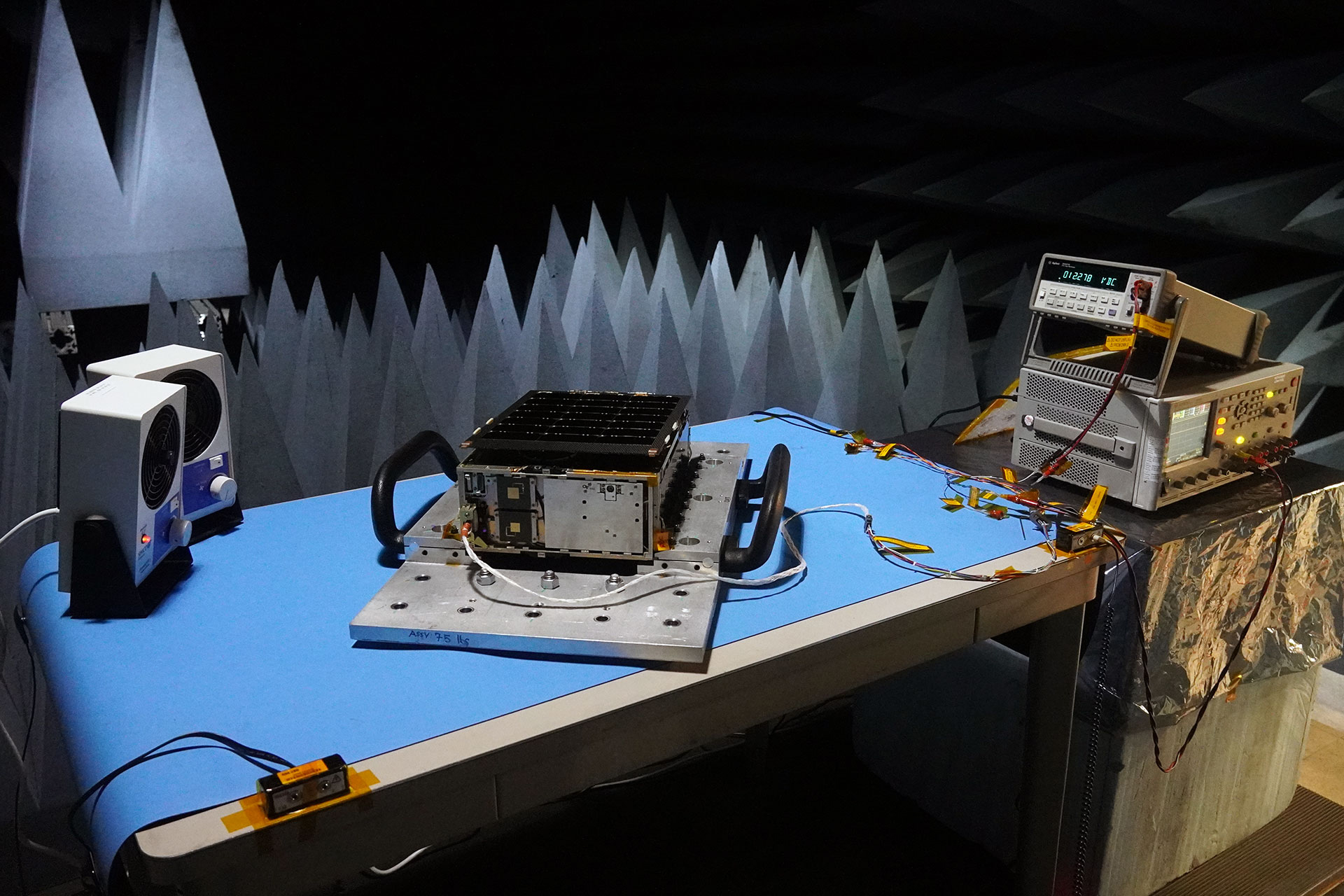
Lunar Flashlight is evaluated in a GTRI anechoic chamber to ensure that its component systems will not create electromagnetic interference. (Credit: Nathan Cheek)
Demonstrating the Capabilities of Small Spacecraft
Until now, CubeSats – named for their use of standard-sized cubic modules – have mostly taken on tasks in Earth orbit, and have not needed powerful propulsion systems. Lunar Flashlight will help demonstrate the ability of small and relatively inexpensive spacecraft to handle important space missions that had previously been reserved for larger vehicles.
“Lunar Flashlight is a modern space mission with a serious science objective,” said Glenn Lightsey, a professor in Georgia Tech’s School of Aerospace Engineering and co-principal investigator for the Lunar Flashlight project. “The discovery of ice on the moon is strategic for human exploration. The ice could be measured by a larger and more expensive satellite, but using smaller spacecraft is more responsive and may be more cost effective.”
Lunar Flashlight is one of several missions planned for the next few years to use small spacecraft to investigate major science challenges. Low-cost CubeSat missions with shortened development times could expand the world’s ability to explore the solar system beyond Earth orbit, but doing so will require enhanced communications systems and improvements in miniaturized systems.
“We expect there to be hundreds of satellites beyond Earth orbit within the next decade, so we need more infrastructure to support these missions,” Lightsey said. “The technology – such as miniaturized propulsion systems – also must be improved.”
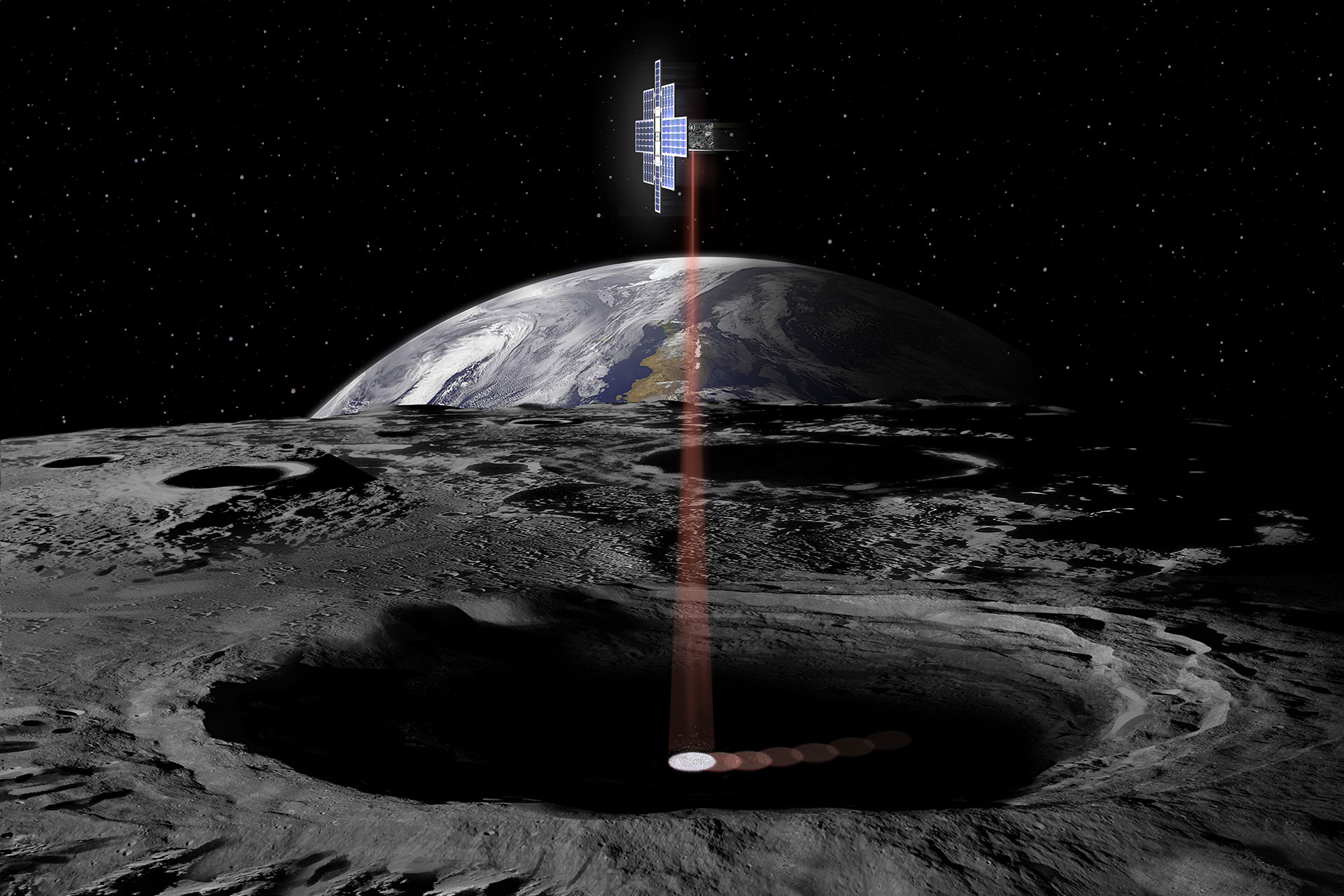
Artist illustration of the Lunar Flashlight’s lasers scanning a shaded lunar crater for the presence of ice. (Credit: NASA/JPL-Caltech)
Firing Lasers to Look for Frozen Water
Lunar Flashlight carries four powerful near-infrared lasers that operate at different wavelengths in the near-infrared spectrum. The lasers will be aimed at shadowed areas of craters, and will operate in sequence to illuminate locations where ice may have been deposited and protected from melting. Water in the form of ice will absorb the laser light, while dry lunar soil – known as regolith – will reflect the beams back to the spacecraft’s spectrometer.
“By studying the light returned, the system will tell us whether water ice is present in these permanently-shaded areas,” said Jud Ready, principal research engineer at GTRI and the Lunar Flashlight project’s principal investigator at Georgia Tech. The Lunar Flashlight science team will interpret the CubeSat’s measurements along with data sets collected by other spacecraft to further understand the abundance and distribution of lunar ice deposits.
The lasers will be powered by a large lithium-ion battery that will be charged by the four solar panels on the spacecraft. The lasers, spectrometer, and battery take up about a third of the Lunar Flashlight’s total volume.
Data from the search for ice will be beamed to NASA’s Deep Space Network by a radio transmitter similar to those used in other NASA missions. The radio will also receive commands sent to the spacecraft from controllers on Earth; because of the time required for signals to be transmitted to the Moon, the commands will be stored and carried out at specific times.
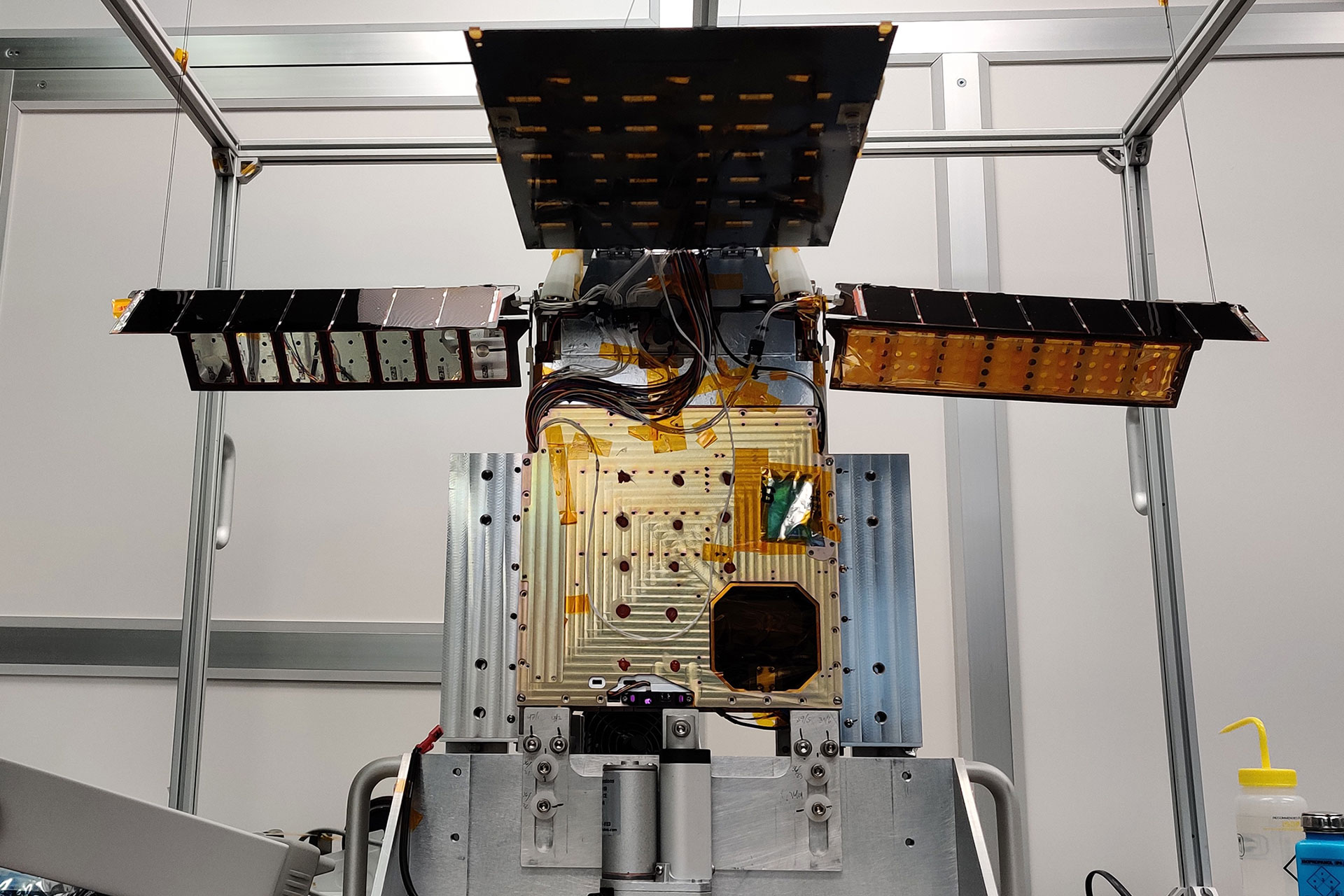
The Lunar Flashlight is shown here at the end of the solar array deployment test. The solar arrays will be stowed for launch and will automatically deploy when the spacecraft is released. (Credit: Conner Awald)
The data will come into Georgia Tech’s mission operations control center, located in the School of Aerospace Engineering, and be forwarded to UCLA for analysis and archiving in the NASA Planetary Data System. Spacecraft controllers at Georgia Tech will monitor the signals to make sure Lunar Flashlight is operating as intended.
Lunar Flashlight’s goal is to address one of NASA’s Strategic Knowledge Gaps: understanding the composition, quantity, distribution, and form of water and water ions – such as hydroxyl (OH) – in lunar cold spots known as “cold traps.”
Previous NASA lunar orbiters and other missions have detected potential water ice deposits at high latitudes on the Moon. Lunar Flashlight will map a handful of those deposits at spatial resolutions of one to two kilometers, providing significantly more detail than earlier missions. Beyond confirming the existence of the frozen water, Lunar Flashlight will provide information that might help determine where future missions might land to sample the water and evaluate its potential use by humans.
Using the Moon’s own water resources for supporting human life and producing fuel could cut the cost of maintaining permanent lunar communities by reducing how much material needs to be launched from Earth. In addition to water, NASA hopes to use lunar materials to make oxygen and propellant for launching return flights.
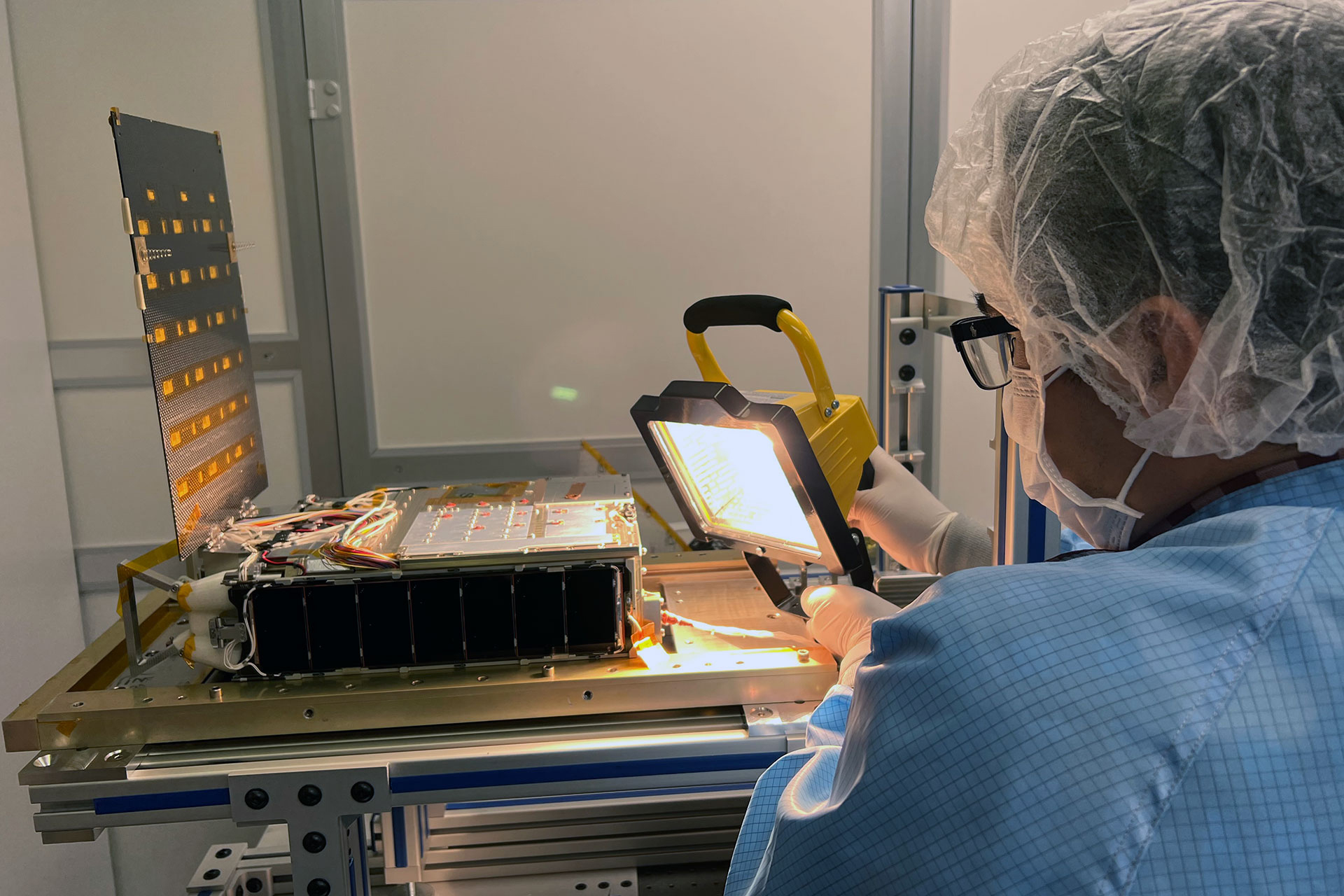
A sensor that will help the Lunar Flashlight maintain proper orientation to the sun is tested in a GTRI laboratory. (Credit: GTRI)
Assembling and Testing Lunar Flashlight
Built in a “6U” (six-unit) CubeSat format (one unit equals one-liter volume), Lunar Flashlight was constructed mostly from commercial off the shelf (COTS) components. These included standard lithium ion batteries, the central processing unit, solar panels, star tracker navigation system, sun sensors, and three-axis reaction wheels for controlling the spacecraft’s position. The spacecraft was sent to Georgia Tech from JPL partially assembled. Using GTRI’s clean room and specialized Atlanta-based facilities, researchers completed the assembly and tested everything. One circuit board and two of the thrusters had to be replaced during the process.
“GTRI was contracted to put the components of the Lunar Flashlight together, putting the upper spacecraft – which is the radio and lasers – to the propulsion system,” said Ready. “We also added and tested the solar arrays, and showed that they will unfurl properly when they reach space.”
After assembling the full spacecraft, GTRI and the School of Aerospace Engineering subjected Lunar Flashlight to qualification testing, making sure it could withstand the strong vibrations associated with launch, operate in a vacuum through extreme temperature changes – and activate its communication system and lasers as expected and without interfering with one another.
More than a dozen graduate and undergraduate students worked on the project, along with several GTRI and School of Aerospace Engineering faculty and staff. Students will also be involved in controlling the spacecraft and supporting the retrieval of the mission data.
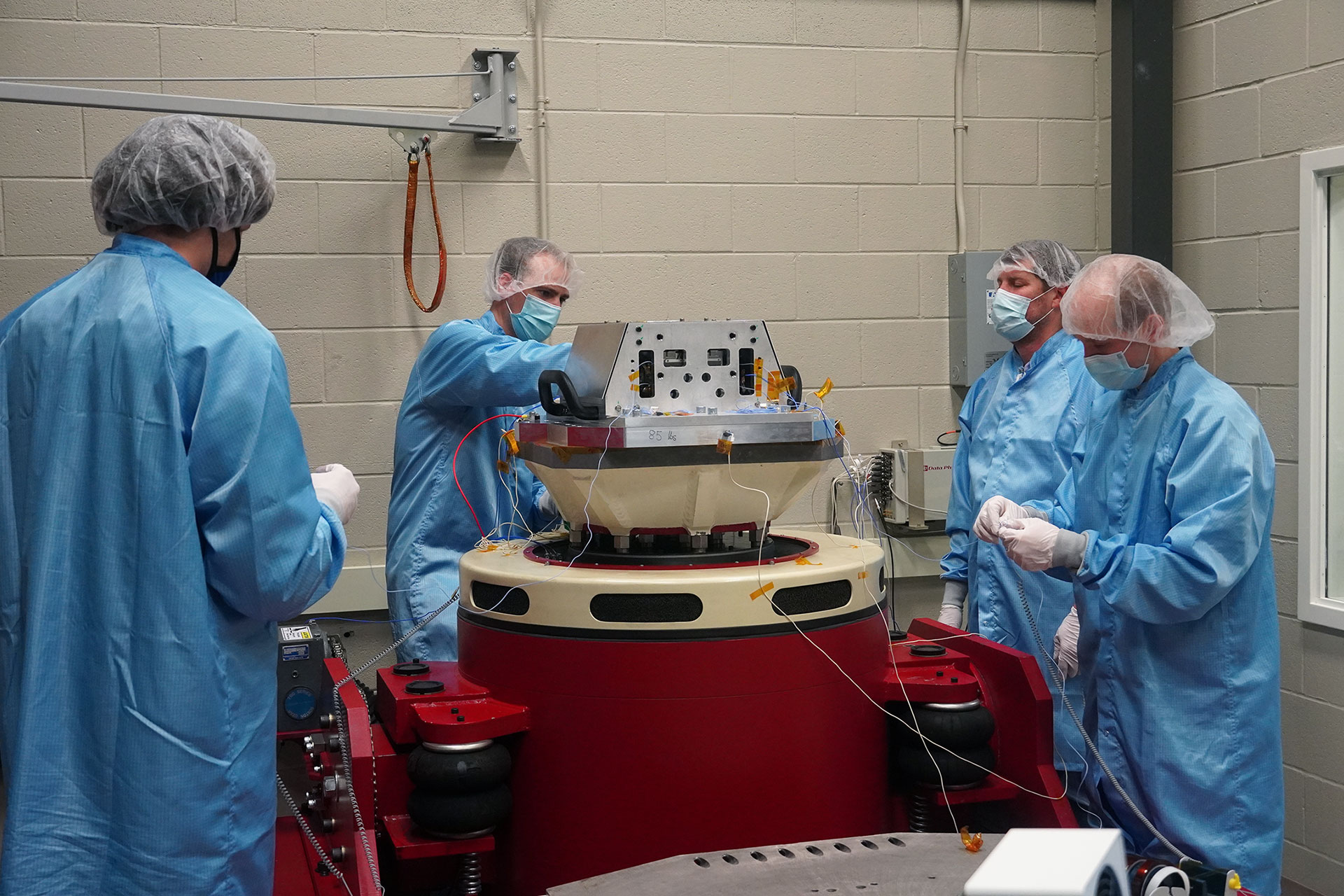
Researchers place the Lunar Flashlight into equipment that will vibrate it to ensure that it can withstand the forces associated with launch. (Credit: Nathan Cheek)
Designing and Building a Small Propulsion System
Lunar Flashlight will enter orbit around the Moon and change its attitude toward the sun, Earth, and lunar surface using a green monopropellant propulsion system designed specifically for the mission. Developed by Georgia Tech’s Space Systems Design Laboratory and MSFC, the system can deliver more than 3,000 Newton-seconds of thrust, but weighs less than six kilograms when fueled.
Lunar Flashlight will be the first planetary spacecraft to use the monopropellant, which does not require a separate oxidizer to produce thrust. Known as Advanced SpaceCraft Energetic Non-Toxic (ASCENT) propellant, it provides enhanced performance at a lower level of toxicity than hydrazine, a conventional spacecraft fuel. Lunar Flashlight’s fuel tank is about the size of a small shoebox.
Most propulsion systems for small spacecraft use cold-gas or electric energy sources, which cannot provide the thrust necessary for the kinds of maneuvers that the Lunar Flashlight mission requires.
“We will command the spacecraft to change its attitude to make sure the solar panels are aligned with the sun,” Ready explained. “But when they are aligned with the sun, the lasers won’t be aimed at the moon. We’ll have to make frequent adjustments to keep the solar panels, lasers and communications system pointed where they need to be.”
Researchers used metal additive manufacturing, custom electronics, and cutting-edge microfluidic components to produce the Lunar Flashlight’s unique propulsion system. With increasing interest in CubeSats for deep-space exploration, they believe the system could find future applications.
“The technology developed here will make maneuverable satellites accessible for more organizations and missions,” said Lightsey. “The Lunar Flashlight propulsion system has the opportunity to be commercialized. It is a modular system, so it does not require specialized expertise to use. It could be incorporated into the design of a small satellite system from the beginning of mission planning.”
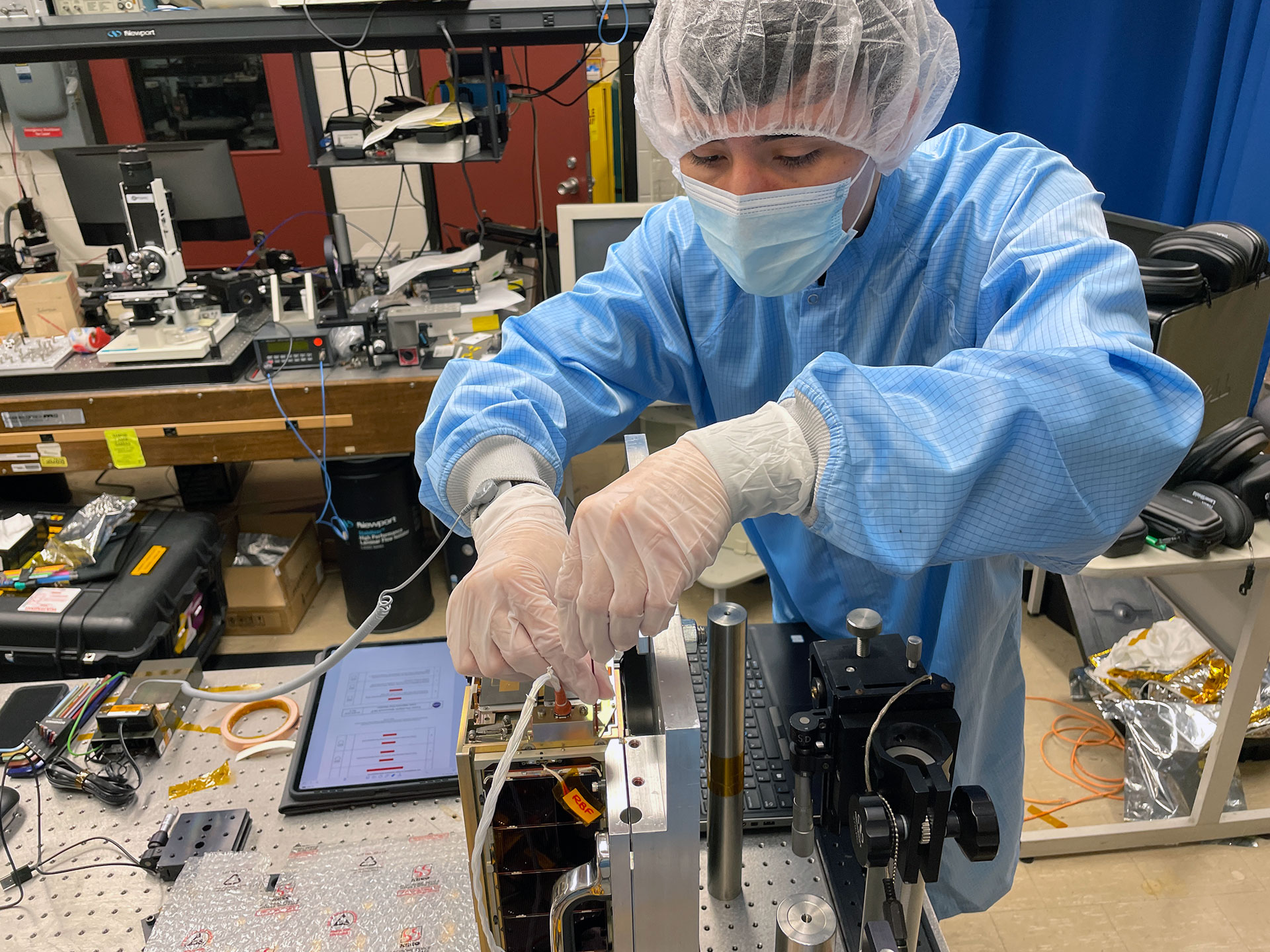
Researcher sets up the Lunar Flashlight to perform a laser alignment test after vibration testing. (Credit: GTRI)
How Will Lunar Flashlight Get to the Moon?
After final assembly is completed at Georgia Tech, Lunar Flashlight will be shipped to MSFC in Huntsville, Alabama, to have the propulsion system fueled. It will then be shipped to the launch provider to be placed aboard a rocket headed to the Moon along with other small spacecraft that will hitch a ride.
While the Moon, on average, is approximately 250,000 miles from Earth, Lunar Flashlight will travel much farther before it begins its science mission. That’s because the spacecraft will make several high-altitude orbits around the Moon to attain the orbital geometry needed to study the lunar south pole. In all, Lunar Flashlight could travel millions of miles over a period of up to four months – depending on the launch vehicle used and position of the Moon and Earth – before its hunt for lunar ice can begin.
Once in its desired polar orbit around the Moon, Lunar Flashlight is designed to complete at least ten science orbits, though the researchers hope it will operate much longer. Having a propulsion system will enable controllers to adjust the spacecraft’s distance from the lunar surface, allowing it to eventually get within 12 kilometers of the surface. Because the Moon has no atmosphere, such close flights are possible.
After its work is completed, Lunar Flashlight will be crashed into the Moon’s surface to remove it from orbit. That will create a new crater about six feet in diameter, an impact that will take place far from the water to avoid potential contamination.
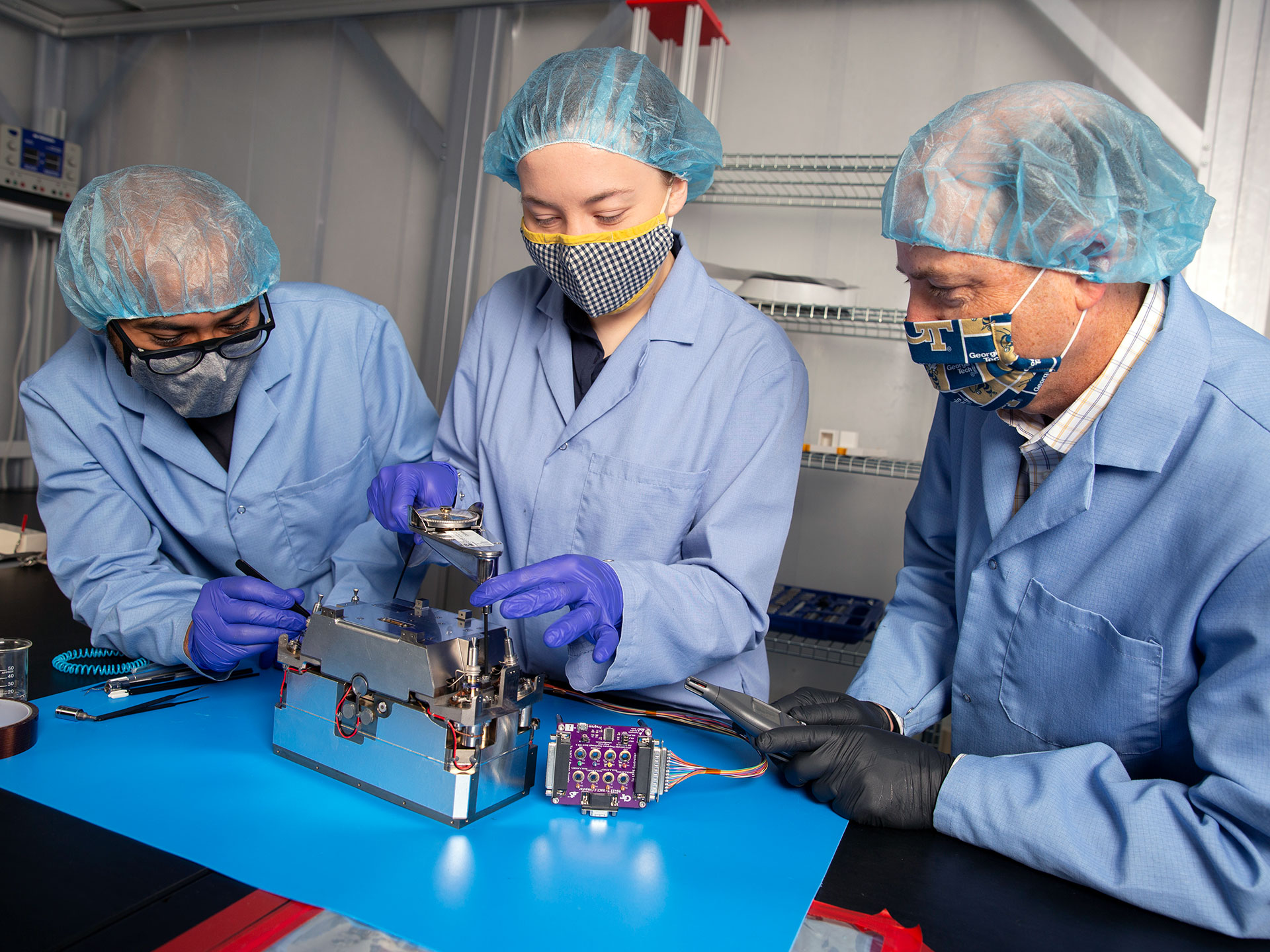
Researchers in Georgia Tech’s School of Aerospace Engineering assemble the Lunar Flashlight’s propulsion system, which will use a special “green” monopropellant to perform course correction maneuvers. (Credit: Candler Hobbs)
Providing a New Capability for Small Spacecraft
The Lunar Flashlight project provides a strong demonstration of the space capabilities at Georgia Tech. By bringing together aerospace engineering and system engineering – including extensive cleanroom capabilities and test facilities – Georgia Tech showed it could meet the needs of a complex space mission.
While Lunar Flashlight will be Georgia Tech’s first lunar mission, it has designed and built small satellites for Earth orbit and collaborated on other missions as far back as the Long Duration Exposure Facility launched in 1984 to study the effects of space on various materials.
“This is a great opportunity to show how GTRI and the academic units of Georgia Tech can work together to accomplish more than a single lab could,” said Lightsey. “Most space projects require expertise and capabilities from multiple technical disciplines. Georgia Tech has a strong tradition in interdisciplinary research, so by bringing experts with different backgrounds and capabilities together, we can provide a complete end-to-end solution.”
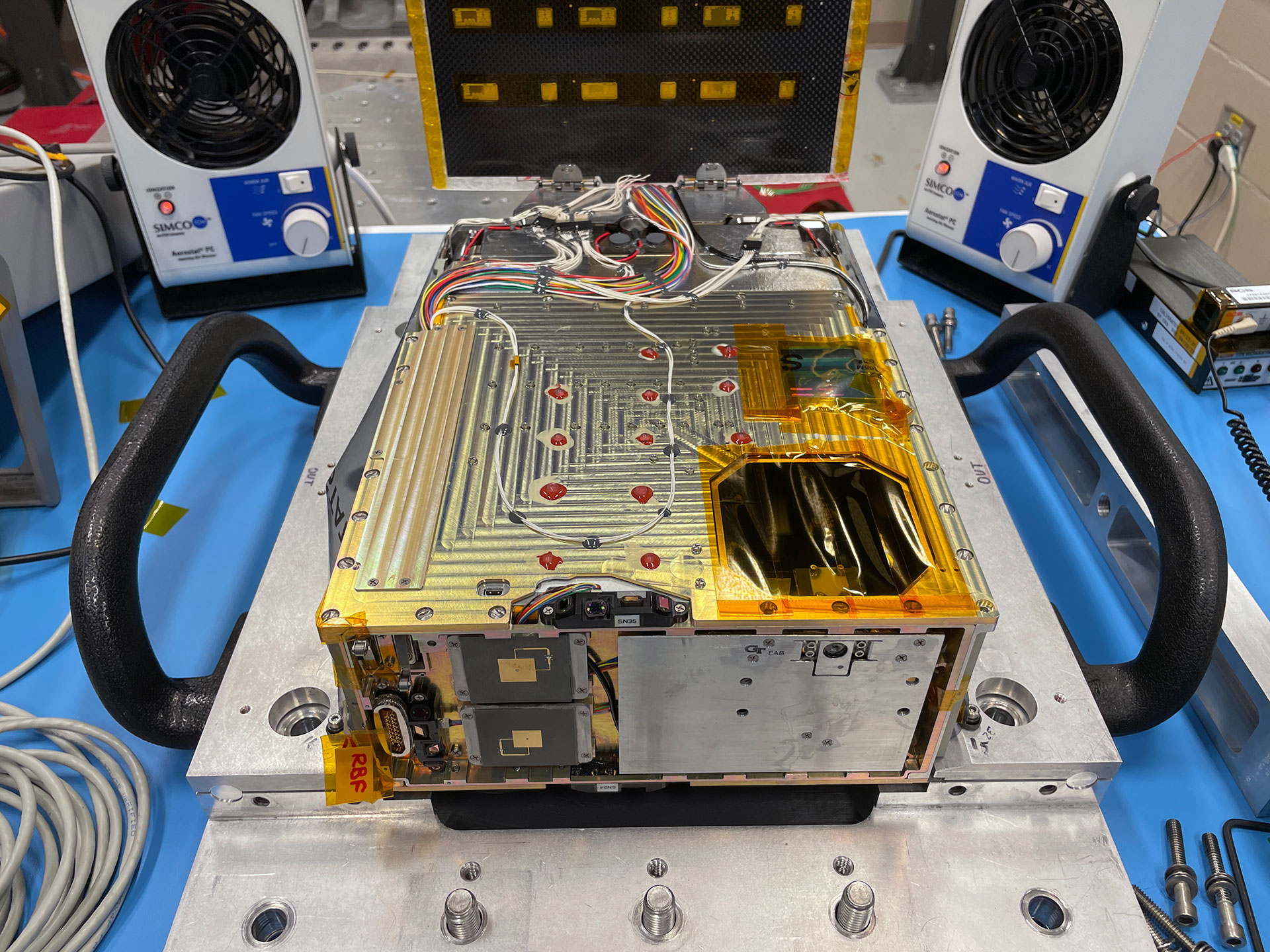
The Lunar Flashlight is a 30-pound spacecraft, shown here during assembly, that will study areas of the Moon’s south polar regions for evidence of ice. (Credit: GTRI)
Writer: John Toon
GTRI Communications
Georgia Tech Research Institute
Atlanta, Georgia USA
![]()
RETURN TO 2021 ANNUAL REPORT HOME
The Georgia Tech Research Institute (GTRI) is the nonprofit, applied research division of the Georgia Institute of Technology (Georgia Tech). Founded in 1934 as the Engineering Experiment Station, GTRI has grown to more than 2,800 employees supporting eight laboratories in over 20 locations around the country and performing more than $700 million of problem-solving research annually for government and industry. GTRI's renowned researchers combine science, engineering, economics, policy, and technical expertise to solve complex problems for the U.S. federal government, state, and industry.




